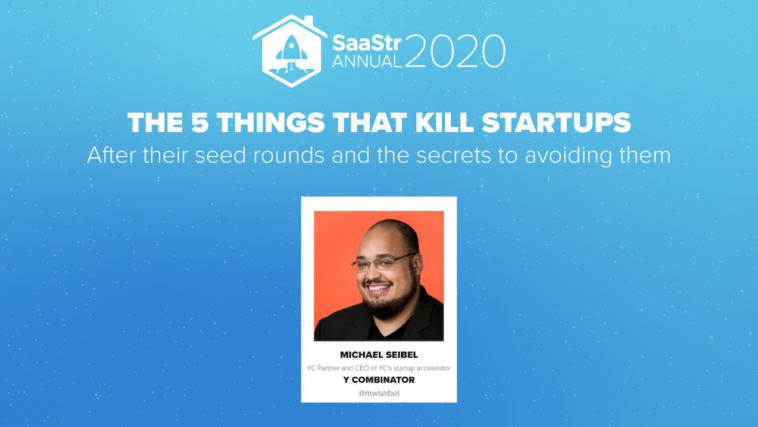- Like
- SHARE
- Digg
- Del
- Tumblr
- VKontakte
- Flattr
- Buffer
- Love This
- Save
- Odnoklassniki
- Meneame
- Blogger
- Amazon
- Yahoo Mail
- Gmail
- AOL
- Newsvine
- HackerNews
- Evernote
- MySpace
- Mail.ru
- Viadeo
- Line
- Comments
- Yummly
- SMS
- Viber
- Telegram
- JOIN
- Skype
- Facebook Messenger
- Kakao
- LiveJournal
- Yammer
- Edgar
- Fintel
- Mix
- Instapaper
- Copy Link
Y Combinator CEO Michael Seibel is featured in one of our most-watched SaaStr videos of all time — so we were delighted to have him back during our SaaStr at Home event to share the top 5 things that kill startups after their seed rounds, and how to avoid them.
In this tactical session, he highlights the trends he’s seen most commonly in startups that die and offers insights on the causes, symptoms, and solutions.
#1 Fake product-market fit
You’re company building before product building.
This is one of the most common symptoms of “impending death” for post-seed companies. So why do founders believe they have market fit, even if they don’t?
Causes:
- Raising money from impressive people
- Raising a series of pre-product market fit
- Magical thinking (ignoring the obvious!)
- Lack of strong technical talent
There is a common misconception that product-market fit means you’ve conceptually built what buyers want. However, this is not the case. Reality is, this concept reflects more on numbers.
Signs:
- Lot’s of hiring
- More business people than engineers
- No metrics dashboards
- Too many nice things
- Flat graphs
- Missing estimates but coming up with excuses
- Changing your KPI’s
How do you fix it?
- Pick honest KPI and stick with it
- Track retention carefully
- Cap your burn
- Consider raising less money in your seed round
- Start with strong technology co-founders
- Have a three month essential rule when hiring
- Force revenue generating employees to pay for themselves
- Learn about your investors previous bad investments (this could determine your fate!)
#2 Investor = Boss
You’re allowing your investor to tell you what to do.
Your investor can only use one thing… WORDS. If you don’t follow a piece of advice or guidance they give you, we promise they won’t kidnap your family and ransack you for money.
Causes:
- Fear and self-doubt
- False assumption there are 100 repeatable paths to victory
- Lack of talking to customers
Signs:
- Feeling pressured to spend more than you want
- Hiring faster than you thought or created a plan for
- Burning more money, while your KPI remains the same
- Locking in one investor and cutting off all communication with others
How to prevent this?
- Talk to more customers
- Have real KPI and real metrics
- Track retention
- Keep a low burn
- Startup in a space you have organic insights in
- Remember, you’re the one who gives investors power over your business
#3 Co-founder conflict
Too much relationship debt is another way to look at this failure leading situation. The truth is, if you don’t have a good relationship with your investors and co-founders, you will crash and burn.
Causes:
- Weak previous relationship
- No clear roles or responsibilities
- Lack of trust
- Unrealistic expectations
Signs:
- Lots of fighting
- No conversations
How to prevent this:
- Have the tough conversation about how you’re feeling- let it all loose in a safe space.
- Establish explicit roles and responsibilities in a conversation.
#4 Ordinary vs. extraordinary
If you expect to be able to copy those around you and be astronomically successful, you are sadly mistaken. In other professions such as doctors, or lawyers if you have a good mentor you’ll most likely be able to copy their path to success. However, in the business world, what works for some may not be the path for others.
How do you reach to be extraordinary?
Causes:
- Understand people around you are the floor and not the ceiling
- Not believing you can be better than the people around you and having no confidence in yourself
Signs:
- No numerical goals
- Ignoring the obvious signs of a lack of progress
- A good sign- you’re just happy to be alive
- You’ve stopped learning
- Blaming outside factors for your lack of success or “luck”
How to prevent this:
- Embrace the idea you can always improve over time if you try
- Think about habit formation
- Have a jedi counsel (aka a set of people you can receive advice from who are more extraordinary than you)
- Set measurable goals
#5 Slow product development
Your features, iterations, and bug fixes don’t ship.
If you’re constantly changing paths or projects, and feel you’re too busy to interact with customers; LISTEN UP!
Causes:
- No process for deciding what to build
- You have no deadlines
- You don’t write specs
- Engineers aren’t involved in park decisions
- No metrics
- No customer interaction
- Bad co-founder relationships
- Low quality product or technology founders
Signs:
- Deadlines always missed or no deadlines
- Release schedule is becoming longer
- Discouraged or disengaged engineering team
- Half done features piling up
How to prevent this:
- Have a product development cycle
- Always be collecting qualitative and quantitative feedback
- Write Specs
- Use product management software
- Small team= everyone’s included in product brainstorms
- Give all team members access to customers and access to customer data
- Understand motivation is a multiplier effect on talent
- Understand whoevers leading product is responsible for making sure that product is released


